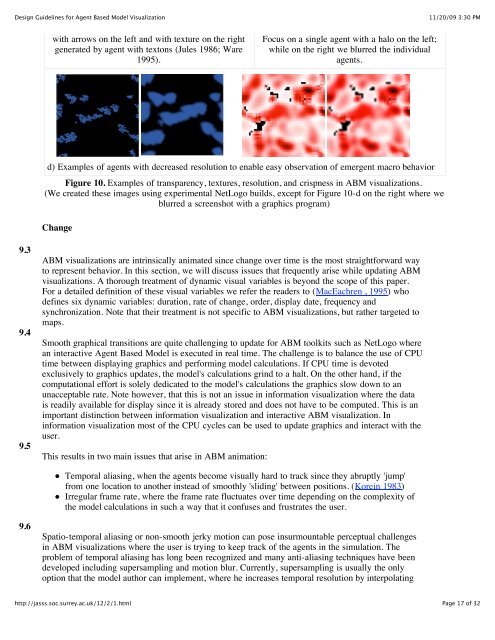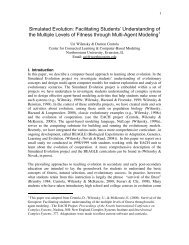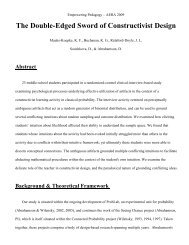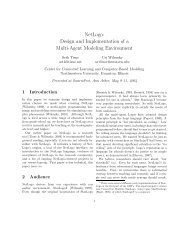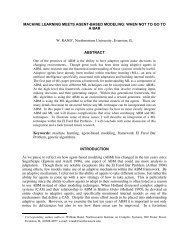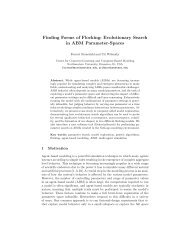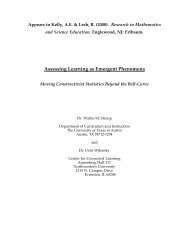Design Guidelines for Agent Based Model Visualization
Design Guidelines for Agent Based Model Visualization
Design Guidelines for Agent Based Model Visualization
You also want an ePaper? Increase the reach of your titles
YUMPU automatically turns print PDFs into web optimized ePapers that Google loves.
<strong>Design</strong> <strong>Guidelines</strong> <strong>for</strong> <strong>Agent</strong> <strong>Based</strong> <strong>Model</strong> <strong>Visualization</strong><br />
9.3<br />
9.4<br />
9.5<br />
9.6<br />
with arrows on the left and with texture on the right<br />
generated by agent with textons (Jules 1986; Ware<br />
1995).<br />
http://jasss.soc.surrey.ac.uk/12/2/1.html<br />
Focus on a single agent with a halo on the left;<br />
while on the right we blurred the individual<br />
agents.<br />
d) Examples of agents with decreased resolution to enable easy observation of emergent macro behavior<br />
Figure 10. Examples of transparency, textures, resolution, and crispness in ABM visualizations.<br />
(We created these images using experimental NetLogo builds, except <strong>for</strong> Figure 10-d on the right where we<br />
blurred a screenshot with a graphics program)<br />
Change<br />
ABM visualizations are intrinsically animated since change over time is the most straight<strong>for</strong>ward way<br />
to represent behavior. In this section, we will discuss issues that frequently arise while updating ABM<br />
visualizations. A thorough treatment of dynamic visual variables is beyond the scope of this paper.<br />
For a detailed definition of these visual variables we refer the readers to (MacEachren , 1995) who<br />
defines six dynamic variables: duration, rate of change, order, display date, frequency and<br />
synchronization. Note that their treatment is not specific to ABM visualizations, but rather targeted to<br />
maps.<br />
Smooth graphical transitions are quite challenging to update <strong>for</strong> ABM toolkits such as NetLogo where<br />
an interactive <strong>Agent</strong> <strong>Based</strong> <strong>Model</strong> is executed in real time. The challenge is to balance the use of CPU<br />
time between displaying graphics and per<strong>for</strong>ming model calculations. If CPU time is devoted<br />
exclusively to graphics updates, the model's calculations grind to a halt. On the other hand, if the<br />
computational ef<strong>for</strong>t is solely dedicated to the model's calculations the graphics slow down to an<br />
unacceptable rate. Note however, that this is not an issue in in<strong>for</strong>mation visualization where the data<br />
is readily available <strong>for</strong> display since it is already stored and does not have to be computed. This is an<br />
important distinction between in<strong>for</strong>mation visualization and interactive ABM visualization. In<br />
in<strong>for</strong>mation visualization most of the CPU cycles can be used to update graphics and interact with the<br />
user.<br />
This results in two main issues that arise in ABM animation:<br />
Temporal aliasing, when the agents become visually hard to track since they abruptly 'jump'<br />
from one location to another instead of smoothly 'sliding' between positions. (Korein 1983)<br />
Irregular frame rate, where the frame rate fluctuates over time depending on the complexity of<br />
the model calculations in such a way that it confuses and frustrates the user.<br />
Spatio-temporal aliasing or non-smooth jerky motion can pose insurmountable perceptual challenges<br />
in ABM visualizations where the user is trying to keep track of the agents in the simulation. The<br />
problem of temporal aliasing has long been recognized and many anti-aliasing techniques have been<br />
developed including supersampling and motion blur. Currently, supersampling is usually the only<br />
option that the model author can implement, where he increases temporal resolution by interpolating<br />
11/20/09 3:30 PM<br />
Page 17 of 32


